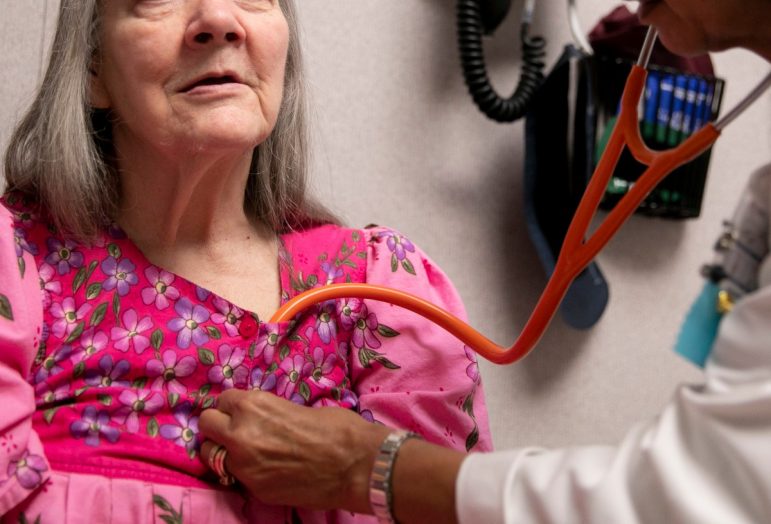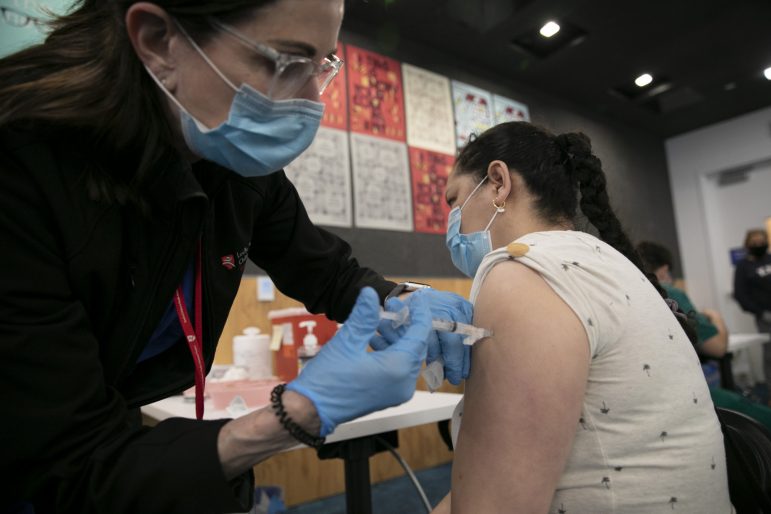In March 2020, as Californians hunkered down for what many expected to be a two-week lockdown, high-ranking health officials were scrambling to find out how many COVID-19 patients were hospitalized, how many were in intensive care and how many beds remained available.
With no system in place for hospitals to report this information to the state and share it, Secretary of Health and Human Services Dr. Mark Ghaly, the state’s public health director and other staff had to call 426 hospitals to assess the situation.
Now, officials hope to avoid similar scenarios in the future by changing the way patient data is collected and shared. Legislation passed last year requires all health and human services providers to sign a statewide data-sharing agreement. This includes hospitals, doctor’s offices, nursing homes, public health agencies, laboratories, mental and behavioral health providers, substance use treatment facilities, insurance plans, public health departments and emergency services.
The final version of the agreement will be published July 1. Most participants will have six months to sign the agreement and a year to begin sharing data.
If implementation goes as planned, a doctor or case worker could request a patient’s full medical and social services history in real time. Patients could view their own records easily, and government agencies would also have access to more reliable aggregate data on patient outcomes and demographics — rendering the pandemic scramble obsolete.
“Myself along with our (California Department of Public Health) director and lots of staff were reaching out to hospitals across the state,” Health and Human Services Secretary Dr. Mark Ghaly said. “We depended early on on phone calls and asking charge nurses and the shift managers at different hospitals ‘What is your COVID burden in the emergency room and around the wards?’”

The health care industry already amasses incredible amounts of patient data. John Ohanian, chief data officer for the state Health and Human Services Agency, likens it to “freeways of information.” The problem is, not everyone has an on ramp to the freeway.
“Our goal was — and the governor’s goal was — to make it mandatory that people exchange information and provide rules of the road and guidelines so it can be done well,” Ohanian said.
It’s a huge endeavor for the state, and not everyone is on board.
In a public comment responding to a draft of the agreement, the California Hospital Association and California Association of Public Hospitals and Health Systems complained that the requirements exceed the statutory authority of the law that established the data-sharing requirement. When contacted for clarification, hospital association spokesperson Jan Emerson-Shea said there was nothing to add beyond what was in the letter.
The California Association of Health Plans also commented that parts of the draft proposal go beyond the scope of the new data-sharing law, including the proposed governing body that would oversee compliance. The association also pointed out potential conflicts with a parallel federal effort to create a national data exchange for health data.
Other groups, including the County Welfare Directors Association of California, County Behavioral Health Directors Association and Planned Parenthood Affiliates of California, raised concerns about data privacy and security. They also want patients to be given the ability to choose whether their data is shared and noted that addiction and mental health records are more strictly protected than other health data. In a letter to the state, Planned Parenthood asked to delay implementation by one year.
Ghaly said there are no plans to extend the timeline, and that other states have already executed similar plans.
“I often take a lot of pride in how California leads and innovates, but we are not innovating here. We are in some ways catching up,” Ghaly said.
Ohanian acknowledged the timeline was “aggressive,” but said the pandemic drove home the need for public health and social services data to be accessible instantly.
“There’s a reason why we’re pushing for an accelerated timeline. It’s because people need to have this information in their hands,” Ohanian said.
According to a state analysis, the proportion of medical and social services organizations that currently use digital records and share that information with other providers varies widely based on sector and location.
While 97% of family physicians used electronic record-keeping methods in 2020, those who didn’t tended to be small independent practices or they were in rural areas. Likewise, 90% of medium and large hospitals also used electronic-only patient records, but only 70% of small hospitals in the state used digital records.
The report found a little more than a third of addiction treatment centers used electronic records to document treatment plans and view laboratory results. Less than half of nursing homes used electronic records and only 10% reported that their systems connected with local hospitals.
Some of the organizations with the fewest digital record-sharing systems are government agencies like county public health and social services departments. “Many types of public health data are collected and transmitted via paper-based, phone, fax, or other non-machine-readable formats,” the report said. It also noted that hospitals frequently cited the inability of local public health offices to send or receive digital records as a major impediment. This caused problems early in the pandemic when public health labs were the only ones able to conduct COVID-19 tests, Ghaly said.
“That information, unless it was carried by paper or shared by fax…it was invisible, gone. It didn’t exist for those on the health care services side,” he said.
The state Legislature’s approved budget includes $50 million over two years to help small doctor’s offices, rural hospitals and community organizations invest in the technology needed to comply with the law.
Even before the pandemic, community clinics and social services providers like homeless shelters say disconnected record-keeping systems caused chronic problems.
“On average our staff spend 50% of their time doing paperwork and administrative stuff and 50% doing direct service. If the government eliminated some of the bureaucracy, we could double services with the same number of employees,” Bay Area Community Services CEO Jamie Almanza said.
Community Services provides emergency housing, intensive case management and mental health services for seven Bay Area counties. Working in all three fields allows it to see the “breakdowns in the system,” Almanza said.
On any given day, 2,000 people live in Community Services shelters, but each of the seven counties it works with uses separate systems for medical, mental health and housing records — all of which differ from the organization’s internal software. This creates duplicative work, especially when its clients access services in multiple counties, which is a common occurrence.
“Just in Alameda County I’m putting data into four different systems,” Almanza said. “Say a client needs to leave Oakland and we enroll them in housing in Contra Costa County: I have to redo the same thing even though it’s the same client five minutes away.”
Almanza sits on the data exchange advisory group, which has met nine times since the legislation passed last year. He said while there are concerns about what implementation will look like, most stakeholders agree that improvements need to be made.
“The bureaucracy is a killer. The data exchange committee is trying to collapse that for the whole state, but I think they’re still trying to give a lot of leeway to the jurisdictions,” she said.
On a broader scale, the patchwork of digital accessibility has made it difficult to reduce health disparities for conditions like heart disease and diabetes, both before and during the pandemic, said Kiran Savage-Sangwan, executive director of the California Pan-Ethnic Health Network and a member of the data exchange advisory group.
Pacific Islanders statewide experienced the highest death rates from COVID-19 in the past two years, and Black Californians saw their death rates increase as vaccination rates stagnated.
Communities of color make up 63% of the state’s population but represent more than 80% of all enrollees in Medi-Cal, the state’s health system for people who can’t afford health insurance. According to a California Health Care Foundation report on health disparities, Black and Latino residents are far more likely to experience preventable hospitalizations for conditions like asthma, heart failure and diabetes than white residents. The same groups are also the most likely to report delaying health care due to cost or lack of insurance.

“The other thing that this system really has the potential to do is to improve our ability to see disparities both on an individual clinical level and on a population health level, because this will require all providers to collect standardized demographic information about consumers,” Savage-Sangwan said.
In recent years, the state has launched ambitious plans to transform the Medi-Cal system through an initiative called CalAIM, which aims to address the root causes of failing health, like food insecurity and housing instability. It offers coverage for services not typically thought of as medical needs, such as housing. CalAIM, along with the state’s Healthy California for All Commission, which is exploring what a single-payer health care system could look like in California, relies on data.
“I can’t think of a thing on our list of huge transformations that won’t either depend on or benefit from this effort,” Ghaly said. “All of these data systems having some ability to come together around the individual is going to accelerate — whether it’s a social worker or an emergency room nurse — their ability to provide more comprehensive and coordinated services.”